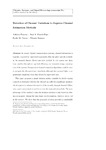Mostrar o rexistro simple do ítem
Detection of channel variations to improve channel estimation methods
| dc.contributor.author | Dapena, Adriana | |
| dc.contributor.author | Castro-Castro, Paula-María | |
| dc.contributor.author | García-Naya, José A. | |
| dc.contributor.author | Zarzoso, Vicente | |
| dc.contributor.other | Facultade de Informática, Departamento de Electrónica e Sistemas, Grupo de Tecnoloxía Electrónica e Comunicacións (GTEC) | es_ES |
| dc.date.accessioned | 2015-10-28T19:40:22Z | |
| dc.date.available | 2015-10-28T19:40:22Z | |
| dc.date.issued | 2014-08 | |
| dc.identifier.citation | Dapena, A., García-Naya, J., Castro, P. & Zarzoso, V. 2014, "Detection of Channel Variations to Improve Channel Estimation Methods", Circuits, Systems, and Signal Processing, vol. 33, no. 8, pp. 2605-2623. | es_ES |
| dc.identifier.issn | 0278-081X (Print) | |
| dc.identifier.issn | 1531-5878 (Online) | |
| dc.identifier.other | DOI 10.1007/s00034-014-9767-8 | |
| dc.identifier.uri | http://hdl.handle.net/2183/15445 | |
| dc.description | “The final publication is available at Springer via http://dx.doi.org/[10.1007/s00034-014-9767-8]” | es_ES |
| dc.description.abstract | [Abstract] In current digital communication systems, channel information is typically acquired by supervised approaches that use pilot symbols included in the transmit frames. Given that pilot symbols do not convey user data, they penalize throughput spectral efficiency, and transmit energy consumption of the system. Unsupervised channel estimation algorithms could be used to mitigate the aforementioned drawbacks although they present higher computational complexity than that offered by supervised ones. This paper proposes a simple decision method suitable for slowly varying channels to determine whether the channel has suffered a significant variation, which requires to estimate the matrix of the recently changed channel. Otherwise, a previous estimate is used to recover the transmitted symbols. The main advantage of this method is that the decision criterion is only based on information acquired during the time frame synchronization, which is carried out at the receiver. We show that the proposed criterion provides a considerable improvement of computational complexity for both supervised and unsupervised methods, without incurring in a penalization in terms of symbol error ratio. Specifically, we consider systems that make use of the popular Alamouti code. Performance evaluation is accomplished by means of simulated channels as well as making use of indoor wireless channels measured using a testbed. | es_ES |
| dc.language.iso | eng | es_ES |
| dc.publisher | Springer | es_ES |
| dc.relation.uri | http://link.springer.com/article/10.1007%2Fs00034-014-9767-8#page-1 | es_ES |
| dc.subject | Channel estimation | es_ES |
| dc.subject | Supervised approach | es_ES |
| dc.subject | Unsupervised approach | es_ES |
| dc.subject | Alamouti code | es_ES |
| dc.title | Detection of channel variations to improve channel estimation methods | es_ES |
| dc.type | info:eu-repo/semantics/article | es_ES |
| dc.rights.access | info:eu-repo/semantics/openAccess | es_ES |
Ficheiros no ítem
Este ítem aparece na(s) seguinte(s) colección(s)
-
GI-GTEC - Artigos [186]






